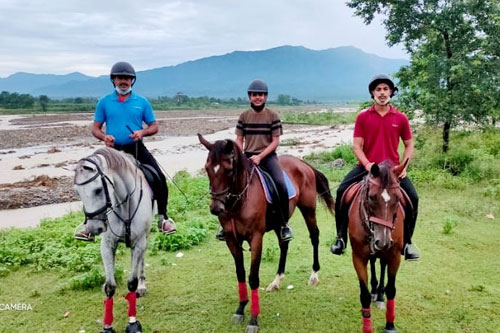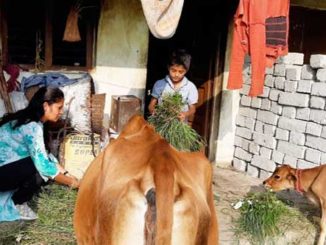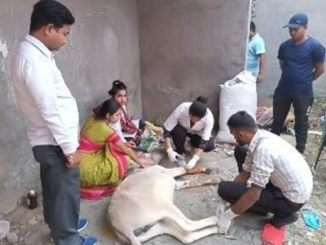Transportation is done for shifting of animals for health issues, breeding issues and for sale & purchase of animals. During transportation it is important that they must be subjected to minimum discomfort and also that it should reach their destination without mental and physical harm.

Guidelines to minimize discomfort during transport
- The degree of comfort required by the animals is comparatively less than the humans and this can be achieved by hygiene, nutrition and exercise required by the animal while static or in transit.
- Time required for transportation should be less as much as possible. Attention should be given to route and method of transport.
- Transport of sick and pregnant animals is governed by various rules. The livestock attended should be fully aware of such animals in their keeping.
- The transportation of aged and fatty animals must be avoided wherever possible and particularly in pig because the new born are more. The initial of journey will have provided adequate restrain or crating (trap) of the animal.
There is various method of transporting animals like air, ship, walking, truck, rail etc. - Seasonal factor is very important in the transport very hot or very cold, icy weather should be avoided.
- If possible, animals should always transport late at night or early in the morning hours.
Means of Transportation
1. By air: Not so developed method and is on an evolutionary stage. This method is adopted when the distance is very large greater than 2000km & time is less.
Nowadays this route is adopted in horses, dogs & in some precious animals. It is an efficient method as it requires less time and all undesirable effects are eliminated (Taking more time, discomfort, and no jerk).
The noise and the movement of air plane leads to excitement and demand very close attention to restrain. Most of the accidents occurring are due to break way of animals. It is important to keep restrain throughout journey.
The dimension of crate is 9x4x7 and the floor of crate should be properly padded.
2. By walking: primitive method and still used in areas away from modern facilities. If used it is for the distance of less than 4-5km. Most important factor in this system is the rate of travel. This allows animals to graze and water themselves properly.
3. By rails: method used in modern areas. It is an efficient method. It is used for the journey round about 200 – 1500km.
- All the animals should be carried in covered truck to avoid from extreme climate.
- Animals shall have good foot hold i.e. it must not be slippery & the suspension system of the truck should be efficient & the floor should be covered with litter (sand, paddy, straw, wheat straw, saw dust etc.). The amount of litter as increases is directly proportional to the comfort up to the certain limit.
- No projection in the inner side of truck.
- All bulls whether horned or polled should be secured by head or neck.
- Avoid down cows (expecting parturition) sick or injured animals must not be transported.
- Different animals separated by some partition by some rod during carriage.
- Overcrowding not allowed and each animal must get sufficient space.
- Sheep must not transport between November and April cold stress. If they are sheared between a period of 60days than no transport of animals because they are in stress condition.
- Watering of animals must be provided & watering of cattle & pig for every 24 hrs (i.e. off- fed and off-watered during transport). If the weather is cold than water given after 6 hrs intervals, sheep watered after every 36 hr.
- Horses must be protected if carried in open truck & must be protected by cloth.
- Horse must be fed and watered for not more than 2hrs.
4. By ship: It is cheap & comfortable but takes more time.
Consignment of transport must be in various classes.
The water and feed facility must be made if journey is more than 18hrs.
5. By road: Mostly used beside rail. Used when distance is moderate 10–100km.
- The vehicle used is ordinary truck, all animals transported in properly constructed box.
- The floor must be filled with sand, saw dust, litter.
- Truck should be properly disinfected after each consignment of animals.
- No projection to prevent injury.
- The means of inspecting the interior must not be more than at a height of 4 Feet 6 inches from ground.
- The inner side of vehicle must be visible from ground.
- There must be movable partition when more than two animals are transported.
Rules to be followed
- Different types of animals carried in different portion and we must follow rules that the crated animals checked within 2–3 hrs routinely.
- Allow period of freedom, each day and exercise.
- Animals exercised in space.
- We must have approved killing instruments in air & sea transportation in emergency cases (injured animal).
- An empty reserve pan should be kept.
Transport of poultry: Prevented from exposure to extreme condition.
- Receptacle properly ventilated.
- Cages not be over crowded.
- Crate properly secured.
- Birds must not be tied with the legs or unnecessary carried head downward.
- Turkey, geese, ducks should not be kept in same receptacle with other animals unless they are kept in separate compartment.
- Food and water must be adequately provided.
- Receptacle must be clean, disinfected and ventilated and all the diseased birds or died birds should be segregated.
“The greatness of a nation and its moral progress can be judged by the way its animals are treated” Mahatma Gandhi






Be the first to comment